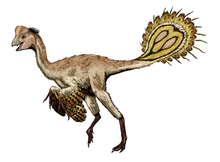Nomingia
| Nomingia Temporal range: Late Cretaceous,
| |
|---|---|

| |
| Diagram showing known elements | |
| Scientific classification | |
| Kingdom: | Animalia |
| Phylum: | Chordata |
| Clade: | Dinosauria |
| Clade: | Saurischia |
| Clade: | Theropoda |
| Family: | †Oviraptoridae |
| Genus: | †Nomingia Barsbold et al. 2000 |
| Species | |
| |
Nomingia is a genus of oviraptorid theropod dinosaur hailing from the Late Cretaceous of Mongolia.
Discovery and naming[]


The remains, consisting of most of the vertebral column, pelvic girdle and left tibio-tarsus, holotype GIN 100/119, were found in 1994 in layers of the Nemegt Svita, dating to the Maastrichtian. They were named and described as the type species Nomingia gobiensis by Barsbold, Halszka Osmólska, , Philip Currie and in 2000. The etymology of the binomial refers to the location where the fossils were found, with the generic name mentioning the , a nearby part of the Gobi Desert, which is itself mentioned in the specific descriptor.[1]
Description[]
Nomingia is a medium-sized oviraptorosaur, estimated by Gregory S. Paul to have been 1.7 metres (5.6 ft) long and 20 kilograms (44 lb) in weight.[2] It is characterized by a pygostyle-like mass of five fused vertebrae at the tail end, which Barsbold et al. inferred probably supported a feather fan as in Caudipteryx.[1] A similar bone structure had only been found in birds before this fossil was discovered.
As other oviraptorids such as Chirostenotes, N. gobiensis would have been a medium-sized theropod sporting beaked jaws and, probably, a crest used for display.
Phylogeny[]
Barsbold et al. only formally assigned Nomingia to a more general Oviraptorosauria, though they considered that it was likely a member of the Caenagnathidae (=Elmisaurinae).[1] Subsequent cladistic analyses have been contradictory regarding to which precise subgroup it belonged.
See also[]
- Timeline of oviraptorosaur research
References[]
- ^ a b c Barsbold, R.; Osmólska, H.; Watabe, M.; Currie, P.J.; Tsogtbaatar, K. (2000). "New Oviraptorosaur (Dinosauria, Theropoda) From Mongolia: The First Dinosaur With A Pygostyle". Acta Palaeontologica Polonica. 45 (2): 97–106.
- ^ Paul, G.S., 2010, The Princeton Field Guide to Dinosaurs, Princeton University Press p. 152
External links[]
- Oviraptorids
- Feathered dinosaurs
- Late Cretaceous dinosaurs of Asia
- Fossils of Mongolia
- Maastrichtian life
- Fossil taxa described in 2000
- Taxa named by Rinchen Barsbold
- Nemegt fauna
- Theropod stubs















